The Reverse Creaming Method for Cakes
Introducing Reverse Creaming also know as Two Stage Creaming.
This is the first in a series of 7 “Cake Batter” classes. Over the course of the series we’ll test how changes to cake batter mixing technique and ingredients can alter a cake’s taste and texture.
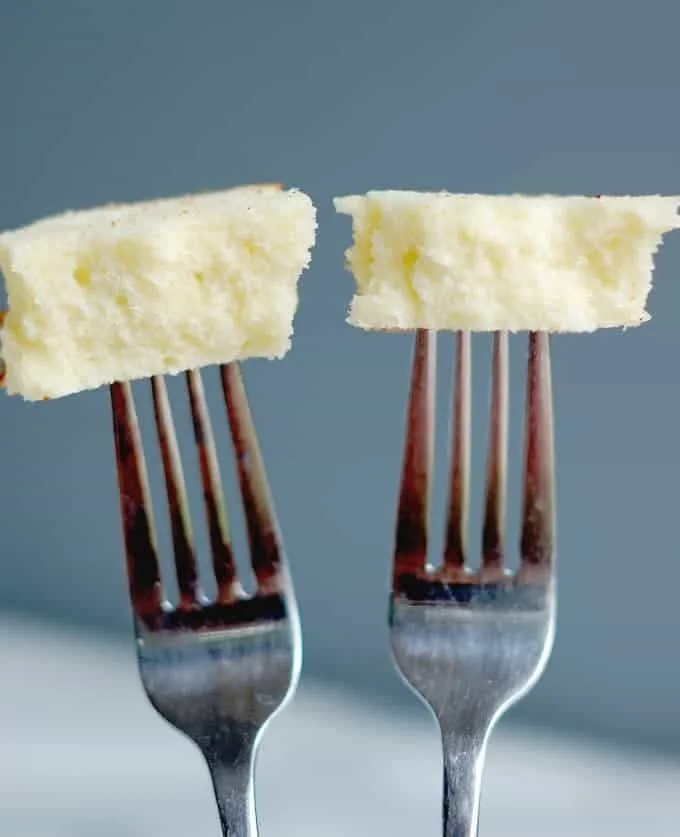
We’ll work with the original pound cake as our test recipe for the “Cake Batter” classes. Pound cake is a great tool for our purposes precisely because it’s a simple recipe with just 4 ingredients.
Pound cake got it’s name based on the original formula of 1 pound each of butter, sugar, eggs and flour. It’s called “quatre-quarts” (four-fourths) by the French.
For our science of cake batter series we’ll look at the role each ingredient plays in the batter. But first we’ll look at two cake batter mixing methods.
Traditional Creaming vs. Reverse Creaming
When I was in culinary school, our first lesson in the “cakes” section was the basic pound cake. Not only did we have to use the original “quatre quarts” recipe, we were required to cream the butter and sugar with a wooden spoon, by hand.
At the time it seemed a little ridiculous. We knew we’d never actually mix a pound cake by hand, especially in a pro kitchen.
But the exercise did reinforce how important technique is, not only for pound cake but for all baking.
What is the creaming method?
The traditional creaming method starts by beating together the butter and sugar. The sharp edges of the sugar crystals cut through the butter to create lots of little air bubbles. The eggs are added one at a time and the flour is added last.
As soon as the flour is added gluten, the protein in the flour that gives baked goods their structure, will start to form. As the cake bakes the air bubbles trapped in the butter will expand in the heat of the oven producing, in theory, a light and airy cake.
What is Reverse Creaming?
Reverse creaming, aka two-stage creaming, is an alternate technique used by many bakers (including me). Reverse creaming starts by beating together the flour, sugar and butter.
Gluten won’t start to form until the flour comes in contact with water (in the egg whites). Coating the flour molecules with butterfat before the eggs are added creates a barrier which slows the formation of gluten. Reverse creaming should, in theory, make a cake with a more tender and velvety texture.
Cake test – creaming versus reverse creaming
One way to compare mixing techniques is to run side-by-side tests. For each test I mixed one batch using the traditional creaming method and one batch using the reverse creaming method.
Each batch of cake contained exactly 8 ounces each of cake flour, granulated sugar, unsalted butter and eggs. The butter and eggs were at ideal room temperature, between 65-70°F.

- All ingredients were at ideal room temperature, about 65°-70°F.
- All cakes were baked in identical 9”x 5” loaf pans at 325°F in a convection oven.
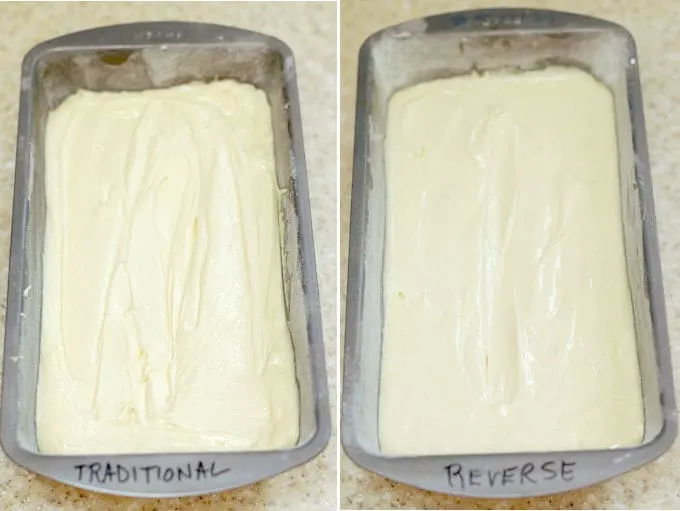
- The cake batters look similar going into the oven.
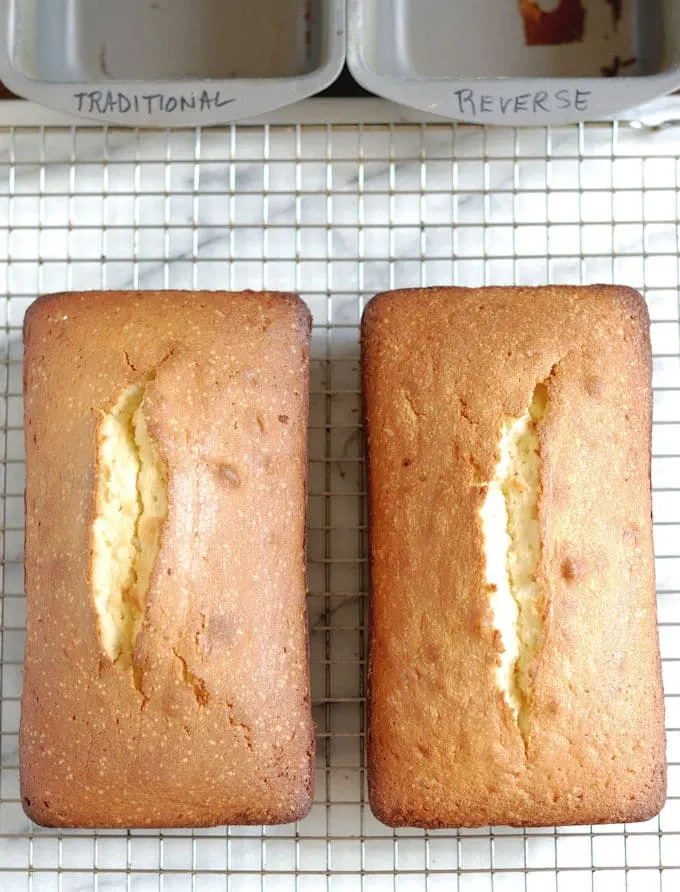
- The crusts on the cakes had slightly different texture.
Creaming vs. Reverse Creaming test results
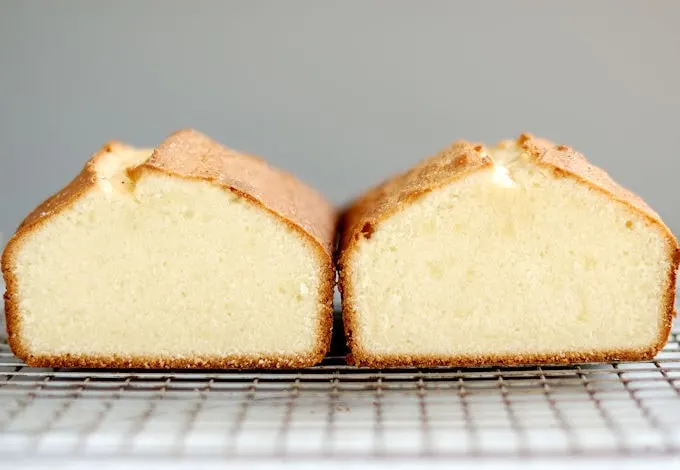
- At first glance, the cakes made with the different mixing methods looked very similar, but once I cut and tasted the cakes the differences became apparent.
- The cake made with the traditional creaming method had a very tight crumb and contained a few pockets of air. The cake was a little chewy with a slightly bouncy texture. I pinched a piece of the cake between my fingers and it held together a moment before breaking up.
- The cake made with the reverse method also had a tight crumb, but it was very consistent with no air pockets. The texture was softer and more tender. When I pinched a piece of that cake between my fingers it broke apart more easily.
Which is better, creaming or reverse creaming?
In tests using the exact same ingredients, a cake made with the reverse creaming method was softer and more tender. Which is why reverse creaming is my preferred mixing method.
Other cake batter classes:
Next up: Cake Batter Class #2 will explore how adding salt, flavorings and leavening can improve on the basic pound cake recipe.
- The function of flour in cake batter
- The function of eggs in cake batter
- The function of sugar in cake batter
- The function of fat in cake batter
- The Cake recipe formula
When we’re done experimenting with all the ingredients for this “cake batter” course, we’ll use all we’ve learned to create Pound Cake Perfection.

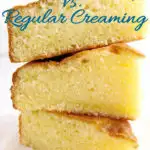
Hi! Can you use the reverse method with a cookie recipe?
I don’t see why not. But, depending on the type of cookie, you may want to get the extra air incorporated with the traditional creaming method. The main reason for using reverse creaming is to have a very tender texture. Since most cookies are very low moisture, developing too much gluten is not usually a big problem.
Just tried your recipe of Perfect Vanilla Pound Cake in your book. Cake is really light, nice texture and very easy to be prepared. We love this pound cake.
We preheat the oven to 300 oF, convection mode with water in the oven for steam cooking. Our pans are made of brown metal thus we drop the cooking temperature to 300 F and cook for an hour. The cake surface is nice without any splitting crack.
Thank a lot for sharing to us your knowledge.
Great! Glad you liked the cake.
Can I use the reverse creaming method for cooking Pound Cakes in a Bundt Pan?
Yes.
Hello Eileen,
I just discovered your site and I think it’s great. I will try to bake this recipe as soon as possible! However, I have a doubt: when mixing the dry ingredients with the butter and afterwards the eggs, do you use the normal wire whip from the mixer or do you use the flat beater? My mixer comes with both accessories and I was wondering if the resulting cake was different depending on which I use. Thanks!
Hi Marina. I always use the flat beater attachment for cake batter. Sorry if that’s not made clear in my directions.
Thanks for the reply! Maybe I missed the baking lesson where you explained that!
I never specifically said to use the flat beater. Perhaps I should. Thanks.
Hello, I’m trying this recipe with the reverse creaming method and have a question about the modified recipe. The reverse creaming is to protect the flour molecules from mixing too long with the liquid but you added milk to the final recipe and suggest mixing in half of it before the eggs. Could you explain why this is and why it is preferred over just mixing all of the milk into the eggs? Great course by the way, thanks for taking the time.
Hi Sophia, I add just a little of the milk because, frankly, it’s just too hard to get the butter to mix in without a little of the milk. Still, because the butter is going in with it and there’s just a little liquid, the flour will be coated with the fat.